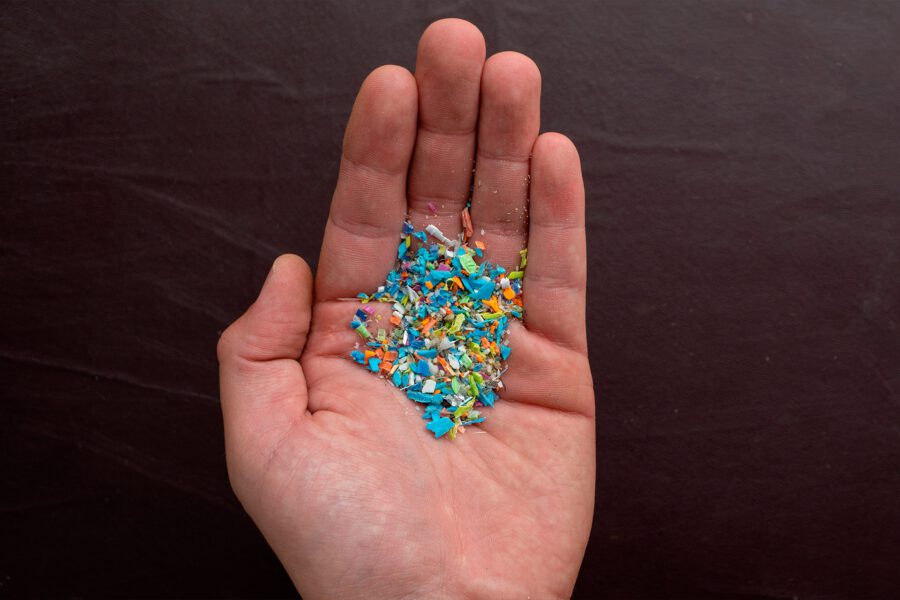The Dangers of Microplastics in Your Health and How to Limit Them
It’s no news. Plastic has been a major problem worldwide for the last decades. Each year, humans produce 350 million metric tons of plastic waste products per year, and this number is expected to continue ballooning by more than 3 times by 2060 if nothing changes.
However, that’s just the tip of the iceberg. We live in a society that overly relies on plastics, from our food and water containers to the synthetic clothes and products we use. It is now known that plastic particles are spread in the air we breathe and absorbed into our systems.
Multiple studies have revealed that we are silently consuming and harboring microplastics in our organs, which leads to chronic diseases, hormonal problems, and certain types of cancers. It is estimated that, on average, we consume 1 credit card of microplastics each week in terms of size.
This begs the question, what are the dangers of microplastics to our health, and how can we overcome them?
This article will discuss the impact of microplastics and provide practical ways to mitigate their effects on overall health and well-being.
Microplastics are tiny plastic particles less than 5 millimeters in size that originate from the breakdown of larger plastic items, synthetic clothing fibers, and personal care products.
Microplastics can spread through the air as particles, which humans and animals can inhale. Once airborne, microplastics can be carried by wind currents and travel long distances, potentially contaminating even remote areas.
In addition to inhalation, humans can also unintentionally consume microplastics through food and beverages that have been contaminated with them. For example, marine life can ingest microplastics, which can then accumulate in the food chain and ultimately be consumed by humans.
Here are some foods that have been found to contain higher levels of microplastics:
- Sardines
- Salmons
- Sea salt
- Bottled water
- Beer
- Honey
- Tea
- Instant rice
- Apples
- Lettuce
- Carrots
- Processed meats
Once inside the body, microplastics can potentially interact with tissues and cells, leading to inflammation and cellular damage.
From the deepest levels of our oceans to the top of Mt. Everest, plastics are present. As of now, we have no way of fully eliminating our exposure to microplastics, and the extent of the health impact of microplastics is not yet fully understood.
The latest studies have documented the presence of microplastics in all parts of the human lungs, testicles, placenta, blood, and breast milk.
Here are some of the potential health hazards of microplastics
When microplastics interact with cells and tissues, they may trigger an immune response, causing inflammation in the affected areas. Chronic inflammation has been linked to the development of various health conditions, such as cancer, cardiovascular diseases, and autoimmune disorders.
Additionally, microplastics may physically damage cells, leading to cell death and potential tissue dysfunction. Studies have shown that people with chronic inflammation and gut health issues are more likely to accumulate microplastics in their gut and abdominal organs.
Chemicals found in plastics, such as phthalates and bisphenol A, can interfere with the body’s natural hormones and disrupt the hormonal balance in your body.
Here are some of the possible effects of microplastics on your hormones:
- Delayed growth spurt
- Disruption in metabolism
- Decrease reproductive function
- Impaired brain functions
The issue of microplastic accumulation has never been more critical in terms of the declining fertility rates observed in recent decades. According to recent data, the average sperm counts of men in Western countries have dropped by more than 50% over the past 40 years.
Although no clear link has been established between overexposure to microplastics and infertility, recent studies have found that humans have three times higher concentrations of microplastics in their testicles than animals. Exposure to microplastics has been found to decrease sperm counts, reduce sperm motility, and cause testicular inflammation.
In rat studies, exposure to microplastics led to a significant decrease in testosterone levels and testicular damage in male rats.
Microplastics can absorb and concentrate harmful chemicals, such as pesticides and heavy metals. Due to their small size and large surface area, microplastics have the ability to attract and accumulate various environmental pollutants.
These pollutants, including pesticides and heavy metals, can adhere to the surface of microplastics. When these contaminated microplastics are ingested or inhaled, the toxic chemicals may be released into the body. Depending on the chemicals involved, this can lead to various adverse health effects.
Exposure to heavy metals found in microplastics has been linked to:
- Neurological disorders
- Kidney damage
- Cancer development
- Hormonal dysfunction
- Growth and development issues
Recent studies have found microplastics in human placentas, raising concerns about the potential impact on fetal development. The placenta is a crucial organ that provides oxygen and nutrients to the developing fetus in the womb and acts as a barrier to protect the fetus from harmful substances.
The exact impact of microplastics found in the placenta is not yet fully understood, but animal models suggest that they might impede heart function and development in developing fetuses.
Long-term exposure to microplastics may indirectly affect fitness performance. Lower levels of testosterone can slow down muscle growth and decrease lifting performance.
Chronic inflammation and irritation in heart and lung tissues can lead to decreased cardiovascular function and oxygen uptake during exercise. Gut issues caused by microplastics can cause an imbalance in the gut microbiome that could potentially lead to nutrient deficiencies, impaired recovery, and decreased athletic performance.
1. Don’t use plastic containers
To reduce exposure to phthalates and other chemicals in food and food packaging, the American Academy of Pediatrics recommends using stainless steel and glass containers instead of plastic whenever possible.
If possible, do not microwave food or beverages in plastic containers. Store food in non-plastic containers such as glass, stainless steel, or silicone containers, which can be used for reheating your food.
Don't put plastic in the dishwasher, as heat can cause chemicals to leak. Check the recycling code on the bottom of products and avoid plastics with recycling code 3, which typically contain phthalates.
Here’s a plan for women you should try:
And for men:
Reduce your use of disposable plastics by bringing reusable bags to the grocery store, using a zippered fabric bag for dry cleaning, and bringing a travel mug for takeout coffee.
When shopping, select products that have minimal or no plastic packaging. Look for items packaged in recyclable materials like paper, glass, or aluminum.
Avoid single-use plastic straws and cutlery. Instead, use reusable alternatives made from metal, bamboo, or glass.
Even the choice of clothing materials matters when it comes to your health. Synthetic fabrics like polyester and nylon shed microfibers when washed, contributing to microplastic pollution. Opt for natural fabrics like cotton, linen, or wool whenever possible.
As a society, we are just now beginning to understand the effects of our reliance on plastics. It’s not just about the tremendous harm that plastic is doing to our environment, but as an individual, we are exposed to the dangers of microplastics in our day to day lives.
Microplastics are not a micro problem. We have a serious health threat that affects everyone in the world and will likely continue to do so if we maintain the status quo.

